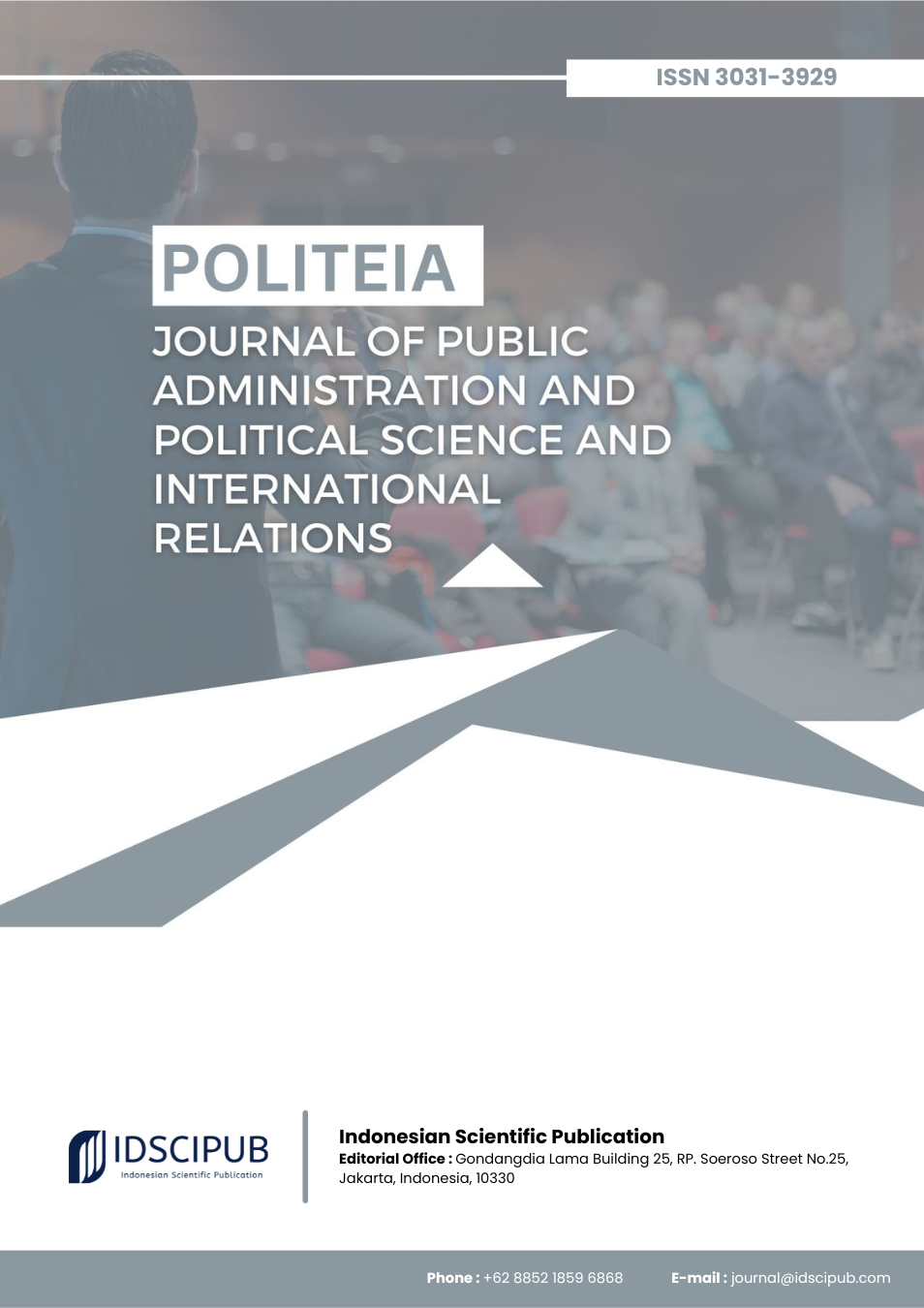Revisiting Trump’s Protectionism and Its Policy Implications for US–Canada Trade Relations
DOI:
https://doi.org/10.61978/politeia.v3i3.606Keywords:
Trump’s Economic Policy, Protectionism, US Trade Relations, Anti-Dumping TariffsAbstract
Amid the rise of economic nationalism and increasing uncertainty in global trade governance, understanding the impact of unilateral trade enforcement on bilateral relations has become critically important. This study explores the resurgence of protectionist policies under President Donald J. Trump, with a particular focus on their effects on U.S.–Canada trade relations and the broader global trend toward economic nationalism. Employing a qualitative case study approach supported by a simple tariff simulation, the research examines how instruments such as anti-dumping (AD) and countervailing duties (CVD) were utilized to protect domestic industries. The simulation indicates that imposing a 21% tariff on Canadian softwood lumber could significantly reduce import volumes while potentially increasing domestic output by 121.8%. However, these protectionist measures also intensified trade tensions, disrupted longstanding alliances, and weakened trust in multilateral institutions such as the WTO. By integrating empirical estimation with policy narrative analysis, this study contributes to the literature on trade policy, emphasizing that while unilateral protectionism may offer short-term domestic advantages, it requires careful calibration with economic diplomacy to ensure the sustainability of global trade cooperation.
References
Abbott, K. W. (2014). Strengthening the Transnational Regime Complex for Climate Change. Transnational Environmental Law, 3(1), 57–88. https://doi.org/10.1017/S2047102513000502 DOI: https://doi.org/10.1017/S2047102513000502
Afandi, H. A., & Sari, R. D. (2024). Analysis of Foreign Investment in Indonesia from the Perspective of State Sovereignty. Politeia: Journal of Public Administration and Political Science and International Relations, 2(4), 365–377.
Amaro, A. (2020). Tariff wars and trade uncertainty: Evidence from global markets. Journal of International Money and Finance, 104, 102178. https://doi.org/10.1016/j.jimonfin.2020.102178 DOI: https://doi.org/10.1016/j.jimonfin.2020.102178
America First: A Budget Blueprint to Make America Great Again. (2017).
Arkananta, H. (2025). Middle-Power Geoeconomics: Indonesia’s Economic Diplomacy in the EV Battery Value Chain between China and the EU. Politeia: Journal of Public Administration and Political Science and International Relations, 3(1), 33–44. https://doi.org/10.61978/politeia.v3i1 DOI: https://doi.org/10.61978/politeia.v3i1.517
Baccini, L., & Kim, S. Y. (2021). Protection for sale or protection for votes? Congressional elections and US trade policy. Economics & Politics, 33(2), 161–184. https://doi.org/10.1111/ecpo.12161 DOI: https://doi.org/10.1111/ecpo.12161
Baker, P., & Austen, I. (2017, April 17). Trump Slaps Tariff on Canadian Lumber, Risking Trade Clash. The New York Times.
Baldwin, R. (2016). The Great Convergence: Information Technology and the New Globalization. Harvard University Press. DOI: https://doi.org/10.2307/j.ctv24w655w
Bercuson, D. J. (2020). Canada’s Historical Search for Trade Markets. The School of Public Policy Publications, 13(19). DOI: https://doi.org/10.55016/ojs/sppp.v13i1.70036
Bernard, A. B., Jensen, J. B., & Schott, P. K. (2006). Survival of the Best Fit: Exposure to Low-Wage Countries and the (Uneven) Growth of U.S. Manufacturing Plants. Journal of International Economics, 68(1), 219–237. DOI: https://doi.org/10.1016/j.jinteco.2005.06.002
Bernstein, S., & Cashore, B. (2002). Globalization, Four Paths of Internationalization and Domestic Policy Change: The Case of EcoForestry in British Columbia, Canada. Canadian Journal of Political Science, 35(1), 67–99. DOI: https://doi.org/10.1017/S0008423900000044
Bown, C. P., & Irwin, D. A. (2019). The Trump trade war: Its motives, manifestations, and the future. Peterson Institute for International Economics.
Burfisher, M. E., Robinson, S., & Thierfelder, K. (2001). The Impact of NAFTA on the United States. Journal of Economic Perspectives, 15(1), 125–144. DOI: https://doi.org/10.1257/jep.15.1.125
Ciuriak, D., & Xiao, J. (2018). Quantifying the USMCA: Trade impacts and beyond. C.D. Howe Institute Commentary. DOI: https://doi.org/10.2139/ssrn.3408666
Drezner, D. W. (2021). Economic Statecraft in the Age of Trump. Survival, 63(1), 7–28. https://doi.org/10.1080/00396338.2021.1881244
Dwyer, P. (2016). Understanding media production: a rejoinder to Murdock and Golding. Media, Culture and Society, 38(8), 1272–1275. https://doi.org/10.1177/0163443716671495 DOI: https://doi.org/10.1177/0163443716671495
Employment Projections (2014–2024 Summary). (2015).
Evenett, S. J. (2020). Sicken thy neighbour: The initial trade policy response to COVID-19. The World Economy, 43(4), 828–839. https://doi.org/10.1111/twec.12954 DOI: https://doi.org/10.1111/twec.12954
Fajgelbaum, P. D., Goldberg, P. K., Kennedy, P. J., & Khandelwal, A. K. (2020). The return to protectionism. The Quarterly Journal of Economics, 135(1), 1–55. https://doi.org/10.1093/qje/qjz036 DOI: https://doi.org/10.1093/qje/qjz036
Freshwater Crawfish Tail Meat from the PRC. (2017).
Gertz, G., & Evers, M. (2020). Geoeconomics: The new frontier of trade and foreign policy. Global Policy, 11(1), 5–15.
Gros, D. (2019). The return of protectionism: Facts and fallacies. Intereconomics, 54(2), 89–93. https://doi.org/10.1007/s10272-019-0792-0 DOI: https://doi.org/10.1007/s10272-019-0797-0
Handley, K., & Limão, N. (2017). Policy Uncertainty, Trade, and Welfare: Theory and Evidence for China and the United States. American Economic Review, 107(9), 2731–2783. DOI: https://doi.org/10.1257/aer.20141419
Hopewell, K. (2021a). Heroes of the developing world? Emerging powers in WTO agriculture negotiations and dispute settlement. Journal of Peasant Studies, 1(24). DOI: https://doi.org/10.1080/03066150.2021.1873292
Hopewell, K. (2021b). Trump and trade: The crisis in the multilateral trading system. New Political Economy, 26(4), 605–620. https://doi.org/10.1080/13563467.2020.1790166 DOI: https://doi.org/10.1080/13563467.2020.1841135
Irwin, D. A. (1998). Changes in U.S. Tariffs: The Role of Import Prices and Commercial Policies. American Economic Review, 88(4), 1015–1026.
Jensen, J. B., Quinn, D. P., & Weymouth, S. (2017). Winners and Losers in International Trade: The Effects on US Presidential Voting. International Organization, 71(3), 423–457. DOI: https://doi.org/10.1017/S0020818317000194
Kim, I. S., & Osgood, I. (2019). Firms in trade and trade politics. Annual Review of Political Science, 22, 399–417. https://doi.org/10.1146/annurev-polisci-050317-070937 DOI: https://doi.org/10.1146/annurev-polisci-050317-063728
Kusumaningrum, D. N., & Prakoso, H. A. (2022). Politik Perdagangan Negara-negara Amerika Utara di Tengah Pesimisme NAFTA. Indonesian Journal of International Relations, 6(1), 87–113. https://doi.org/10.32787/ijir.v6i1.271 DOI: https://doi.org/10.32787/ijir.v6i1.271
Lighthizer, R. E. (2020). The Trump Trade Strategy: A Shift Toward Economic Nationalism. Foreign Affairs.
Malawer, S. S. (2024). Trump and Biden Trade Policies—Has the U.S. Become a National Security and Protectionist Trading State? Journal of East Asia and International Law, 17(1), 1–20. DOI: https://doi.org/10.14330/jeail.2024.17.1.11
Martin, G. J., & Yurukoglu, A. (2017). Bias in Cable News: Persuasion and Polarization. American Economic Review, 107(9), 2565–2599. DOI: https://doi.org/10.1257/aer.20160812
Mavroidis, P. C., & Sapir, A. (2021). China and the WTO: Why multilateralism still matters. Journal of International Economic Law, 24(1), 1–25. https://doi.org/10.1093/jiel/jgab002 DOI: https://doi.org/10.1515/9780691206608
Motion Picture. (2016). Full Event: Donald Trump HUGE 28K Rally in Tampa, Florida. https://www.youtube.com/watch?v=ddxgYS67abI
Oatley, T., & Kim, C. S. (2020). The global trade slowdown: What has changed? Review of International Political Economy, 27(3), 463–485. https://doi.org/10.1080/09692290.2019.1647260
Pierce, J. R., & Schott, P. K. (2016). The Surprisingly Swift Decline of US Manufacturing Employment. American Economic Review, 106(7), 1632–1662. DOI: https://doi.org/10.1257/aer.20131578
Polaski, S. (2006). Winners and Losers: Impact of the Doha Round on Developing Countries. Carnegie Endowment for International Peace.
Presidential Candidate Donald Trump Rally in Grand Rapids, Michigan. (2016, November 7). C-SPAN.
Presidential Executive Order on Establishing Enhanced Collection and Enforcement of Antidumping and Countervailing Duties and Violations of Trade and Customs Laws. (2017).
Rodrik, D. (2018). Straight Talk on Trade: Ideas for a Sane World Economy. Princeton University Press. DOI: https://doi.org/10.1515/9781400888900
Salacuse, J. W. (2010). The Law of Investment Treaties. Oxford University Press. DOI: https://doi.org/10.1093/law/9780199206056.001.0001
Santeramo, F. G., & Lamonaca, E. (2018). The effects of non-tariff measures on agri-food trade: A review and meta-analysis of empirical evidence. Food Policy, 79, 1–17. https://doi.org/10.1016/j.foodpol.2018.04.003 DOI: https://doi.org/10.2139/ssrn.3285107
Story, M. (2005). Free Market Welfare: The case for a Negative Income Tax. Adam Smith Research Trust.
USDA. (2017). Indexes of Prices Paid.
Woods, N. (2023). Multilateralism in the Twenty-First Century. Global Perspectives, 4(1), 68310. https://doi.org/10.1525/gp.2023.68310 DOI: https://doi.org/10.1525/gp.2023.68310







